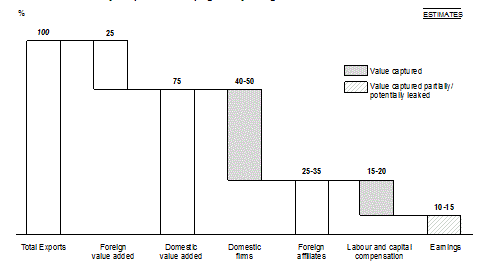The increasing dominance of global value chains (GVCs) in world trade gives developing countries the opportunity to increase their “value capture” – that is, to harvest greater profits, wages, and retained investment – as goods make ever-more-complex international journeys from raw materials to finished products, UNCTAD’s World Investment Report 20131 says.
The report, which is subtitled Global Value Chains: Investment and Trade for Development, was issued today. This year’s report has a special focus on GVCs, building on the UNCTAD report entitled Global Value Chains and Development that was issued in February (see UNCTAD/PRESS/PR/2013/001).
Key findings of the report:
The development contribution of GVCs can be significant. In developing countries, value-added trade contributes nearly 30 per cent to countries’ GDP on average, as compared with 18 per cent for developed countries. And there is a positive correlation between participation in GVCs and GDP per capita growth rates. GVCs have a direct economic impact on value added, jobs and income. They can also be an important avenue for developing countries to build productive capacity, including through technology dissemination and skill-building, opening up opportunities for longer-term industrial upgrading.
However, participation in GVCs also involves risks. The GDP contribution of GVCs can be limited if countries capture only a small share of the value added created in the chain. Also, technology dissemination, and skill building and upgrading, are not automatic. Developing countries face the risk of remaining locked into relatively low value-added activities. In addition, the environmental impacts and social effects – including on working conditions, occupational safety and health, and job security – can be negative. The potential for GVC activities to be “footloose”, and the increased vulnerability to external shocks, pose further risks.
Countries need to make a strategic choice whether to promote or not to promote participation in GVCs. They need to carefully weigh the pros and cons of GVC participation and the costs and benefits of proactive policies to promote GVCs or GVC-led development strategies, in line with their specific situation and factor endowments. Some countries may decide not to promote GVC participation; others may not have a choice. In reality, most are already involved in GVCs to a degree. Promoting participation in GVCs implies targeting specific GVC segments; i.e. GVC promotion can be selective. Moreover, GVC participation is only one aspect of a country’s overall development strategy.
Policy is important in making GVCs “work” for development. Gaining access to TNC-coordinated GVCs, which now account for 80 per cent of the value of global trade, and realizing the upgrading opportunities that GVCs present, requires a structured approach that includes embedding GVCs in industrial development policies (for example, targeting GVC tasks and activities), enabling GVC growth by creating a conducive environment for trade and investment and by putting in place infrastructural prerequisites, and building productive capacities in local firms as well as skills in the local workforce. To mitigate the risks involved in GVC participation, these efforts should take place within a strong environmental, social and governance framework, with strengthened regulation and enforcement, and capacity-building support to local firms, the report recommends.
UNCTAD proposes three specific initiatives:
• Synergistic trade and investment policies and institutions. Trade and investment policies often work in silos. In the context of GVCs, these policies can have unintended and counterproductive reciprocal effects. Policymakers should carefully review those policy instruments that simultaneously affect investment and trade in GVCs – for example, trade measures affecting investment, and investment measures affecting trade. In addition, GVCs call for greater collaboration between trade and investment promotion agencies.
• Regional industrial development compacts. The relevance of regional value chains underscores the importance of regional economic cooperation. Regional industrial development compacts could encompass integrated regional trade and investment agreements focusing on the liberalization and facilitation of trade and investment. They could encourage the establishment of joint trade-promotion and investment-promotion mechanisms and institutions. And they could aim to create cross-border industrial clusters through joint financing for GVC-enabling infrastructure and joint productive capacity-building.
• Sustainable export processing zones (EPZs). Sustainability is becoming an important factor for attracting GVC activities. EPZs have become significant GVC hubs by offering benefits to TNCs and to suppliers to GVCs. The zones could also offer expanded support services for corporate social responsibility (CSR) efforts and infrastructure. Relevant services could include technical assistance for certification and reporting, support on occupational safety and health issues, and recycling or alternative energy facilities.
Full Report - http://unctad.org/en/PublicationsLibrary/wir2013_en.pdf
The role of TNCs in value added trade has implications for “value capture”
Value added trade shares by component, developing country average

Source: World Investment Report 2013
A GVC policy framework for development
Source: World Investment Report 2013
Policymakers need to make sure that investment and trade policy measures work in the same direction
Source: World Investment Report 2013
Regional trade and investment agreements could evolve into regional industrial development compacts
Regional industrial devlopment compacts for regional value chains
Source: World Investment Report 2013
Export processing zones could evolve into centres of excellence for sustainable business
"sustainable export processing zones"
Source: World Investment Report 2013


